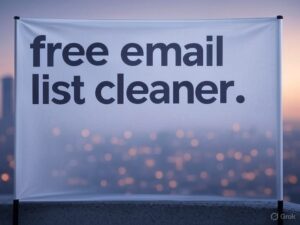Have you ever wondered how big companies talk to their customers? They often use email. An email list is like a special club. People join this club because they want to hear from you. Building an email list can seem hard. However, it can be quite easy. Many free tools are available to help you. We will explore how to start your own free email list. This guide is for everyone. It uses simple words. You do not need to be a computer expert. You just need a little patience.
Email lists are powerful tools. They let you share news directly. You can tell people about new products. You can also share helpful tips. This is much better than waiting for them to find your website. It is a direct line of communication. So, learning about free email lists is a great idea. It can help you reach more people. It can help your business grow. Or, it can just help you share your ideas.
H2: Why Start a Free Email List?
Starting a free email list has many good reasons. First, it is very cost-effective. “Cost-effective” means it saves money. You do not have to pay for expensive ads. Many services let you start for free. You can send emails without spending a dime. This is great for small businesses. It is also good for individuals. Furthermore, an email list gives you control. Social media platforms can change their rules. They can make it hard to reach your followers. With email, you own the connection. No one can take it away. Therefore, building your own list is smart.
Another big benefit is direct communication. When you send an email, it goes straight to an inbox. People often check their email daily. This means your message is likely to be seen. Also, emails feel more personal. It is like sending a letter. People feel a stronger connection to you. This can build trust over time. Consequently, a strong email list helps you build a loyal audience. They will look forward to hearing from you. They will be more likely to support your work. So, starting free is a fantastic first step.
H3: Choosing Your Free Email Service
Choosing the right free email service is important. Many options exist. Each has its own strengths. latest mailing database For example, some are very easy to use. Others offer more advanced features. Most free plans have limits. These limits might be on the number of subscribers. They might also be on the number of emails you can send. You need to pick one that fits your needs. Think about what you want to achieve. Do you just want to send newsletters? Or do you plan to sell products later?
Popular free options include Mailchimp. ConvertKit also has a free plan. AWeber offers a free tier too. Each one is a bit different. Mailchimp is often suggested for beginners. It has a user-friendly interface. “User-friendly” means it is simple to navigate. ConvertKit is popular with creators. Bloggers and YouTubers like it. AWeber is known for good support. Take some time to look at them. Read reviews from other users. Pick one that feels right for you. Remember, you can always change later.

H4: Mailchimp: A Great Starting Point
Mailchimp is a very popular choice. It has a generous free plan. You can have up to 500 contacts. You can send 1,000 emails per month. This is more than enough for many people. Its drag-and-drop editor is simple. You can design beautiful emails easily. You do not need to know any code. Mailchimp also offers ready-made templates. “Templates” are pre-designed layouts. You just add your words and pictures. Furthermore, it helps you understand your audience. It shows you who opens your emails. It also shows you who clicks on links. These insights are very helpful for improving your messages.
Mailchimp integrates with many websites. You can add signup forms easily. This makes collecting emails simple. For instance, if you have a blog, you can add a Mailchimp form. People can sign up right there. The service also provides helpful guides. They have videos and articles. These resources teach you how to use their tools. So, even if you are new, you can learn quickly. Mailchimp is a solid choice. It lets you get started without any cost.
H5: Building Your Signup Form
Once you pick a service, you need a signup form. This is how people join your list. A signup form is a simple box. It asks for an email address. Sometimes, it also asks for a name. Keep your form short and simple. Do not ask for too much information. People are more likely to sign up if it is easy. Think about where to put your form. You can place it on your website. You can also share a link on social media. Make it easy for people to find.
Most email services offer form builders. These tools help you create forms. You can customize the look. You can match it to your website’s colors. Add a clear headline to your form. Tell people what they will get. For example, “Get weekly tips on gardening.” Or, “Join for exclusive discounts.” This encourages people to sign up. Make sure the “subscribe” button stands out. It should be easy to click. A good form helps you get more subscribers.
H6: Ideas for Your First Email
After people join, what do you send? Your first email is very important. It is called a welcome email. This email sets the tone. Thank them for joining your list. Tell them what to expect next. Will you send weekly tips? Monthly updates? Be clear about your schedule. You can also offer a small gift. This could be a free guide. It could be a checklist. This makes them feel special. It also gives them value right away.
Keep your welcome email short and friendly. Use simple language. Avoid jargon. “Jargon” means difficult words. Make sure it looks good on phones. Many people check email on their phones. Test your email before sending it. Send it to yourself first. Check for typos or broken links. Your first email builds trust. It makes subscribers excited for future messages. Always aim to provide value.
Image 1 Description: An illustration showing a bright, friendly looking computer monitor. On the screen, there’s a simple, clear email signup form with fields for “Name” and “Email Address” and a prominent “Subscribe” button. Around the monitor, there are small, floating icons representing mail envelopes, a lightbulb (idea), and a small coin (saving money), all on a soft, light blue background. The overall feeling is approachable and easy.
H3: Growing Your Free Email List
Once you have a service and a form, you need to attract people. Growing your email list takes effort. But it does not have to cost money. There are many free ways to get subscribers. One common way is through your website or blog. Make sure your signup form is easy to see. Put it in different places. You can have it in the sidebar. You can put it at the end of each blog post. A pop-up form can also be effective. However, do not make pop-ups annoying. They should appear at the right time.
Another great place is social media. Share your signup link on Facebook, Instagram, or we spend two hours sharing stories X (Twitter). Tell your followers why they should join. Offer them something exclusive. Maybe a special behind-the-scenes look. Or a free resource. Remember to post about your list often. Not everyone sees every post. Also, consider creating a lead magnet. A “lead magnet” is something valuable you give away. It could be an e-book. It could be a template. People get the magnet when they sign up. This is a very powerful way to grow.
H4: Content Ideas for Your Emails
What should you send to your email list? The content is key. People joined because they want value. Always aim to provide something useful or interesting. One idea is to share tips and tricks. If you have a cooking blog, share recipes. If you talk about fitness, share workout ideas. Another idea is to share updates. Tell them about new products or services. Announce upcoming events. Or share exciting news about your journey.
You can also send behind-the-scenes content. Show them how you marketing list create things. This makes your audience feel special. It builds a deeper connection. Ask questions to encourage replies. This makes the conversation two-way. Remember to keep emails concise. People are busy. Get straight to the point. Use clear headings within your emails. Break up long paragraphs. Use images if they add value. Always provide a clear call to action. Tell them what to do next. For example, “Click here to read more.” Or,
